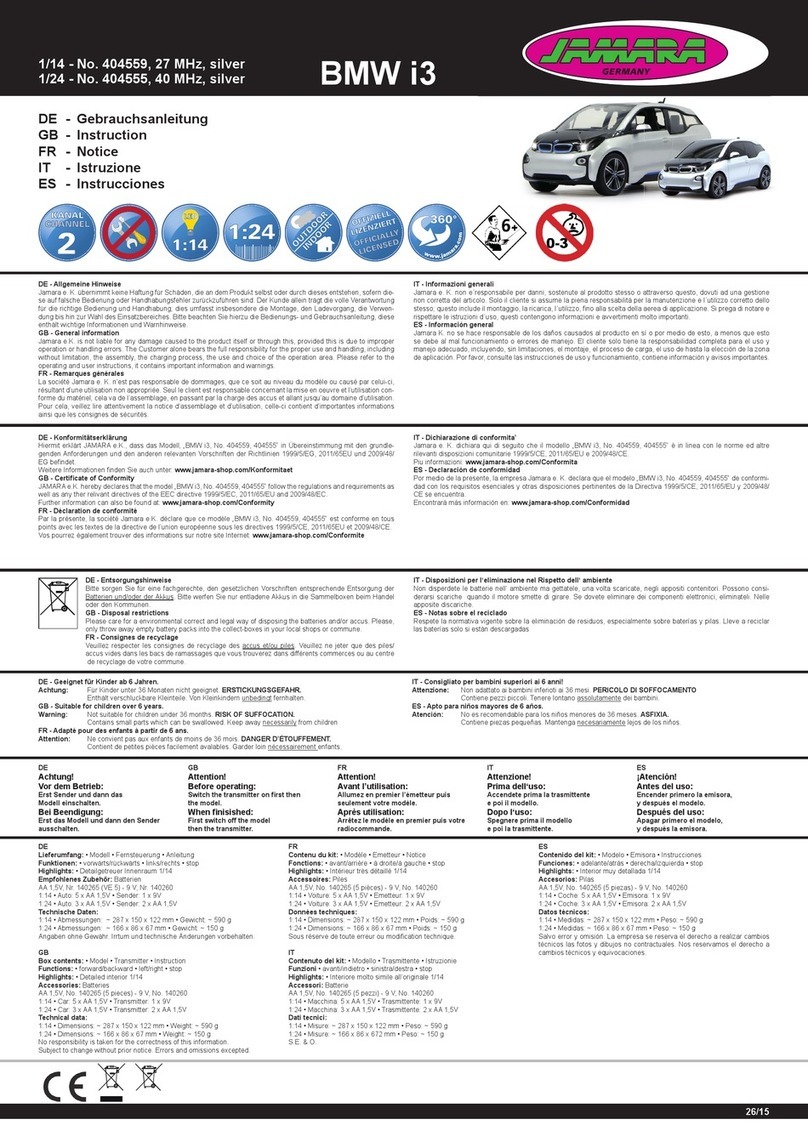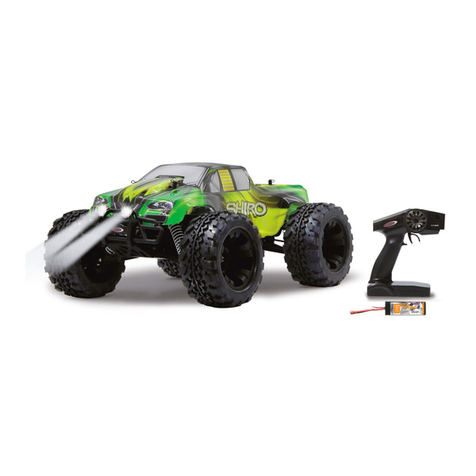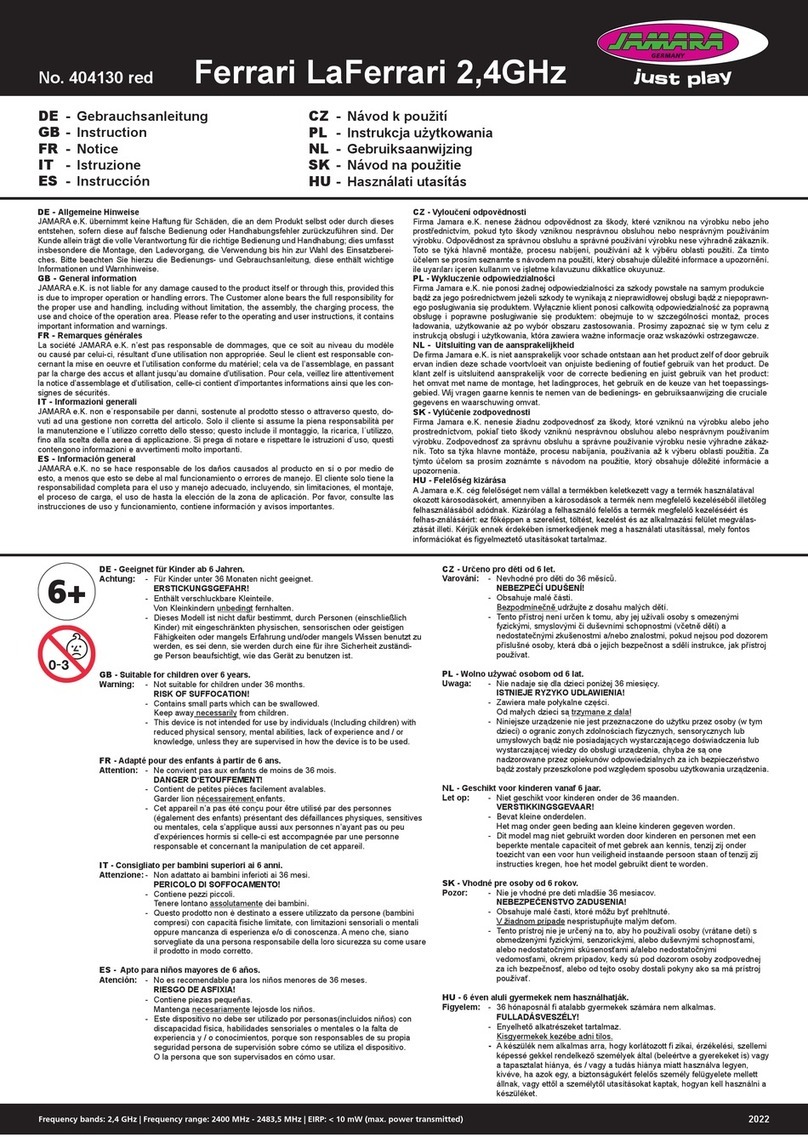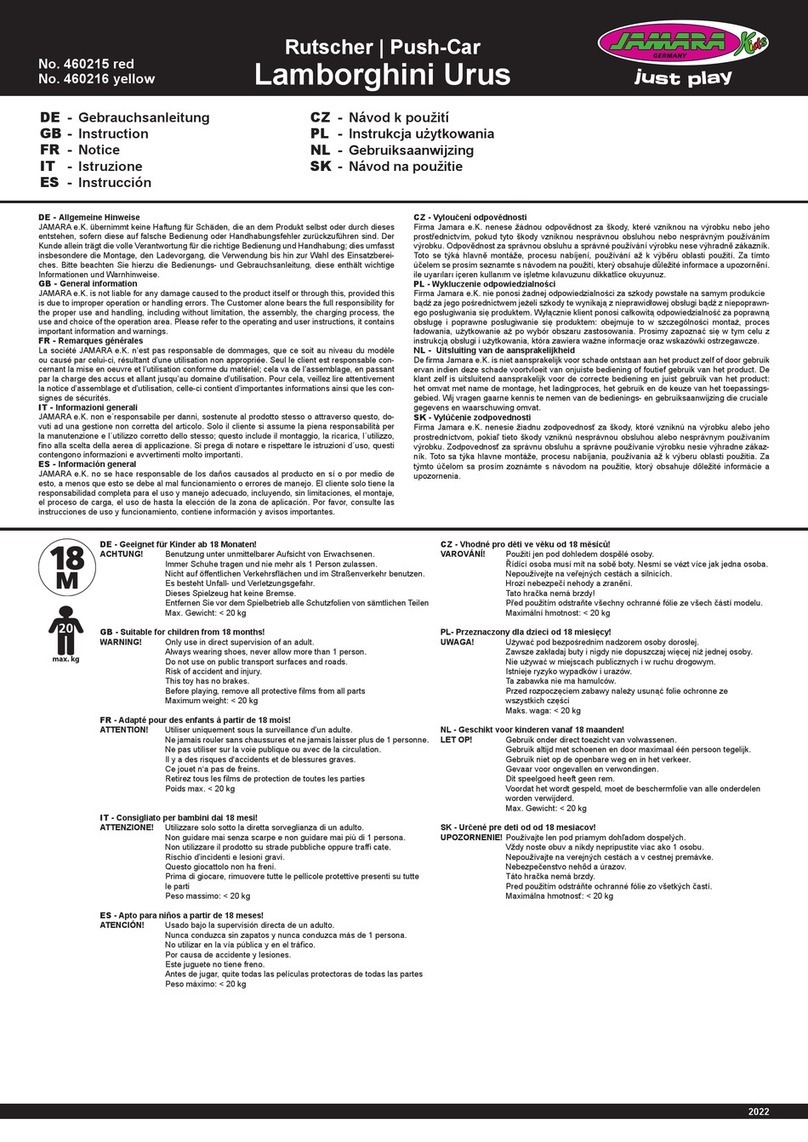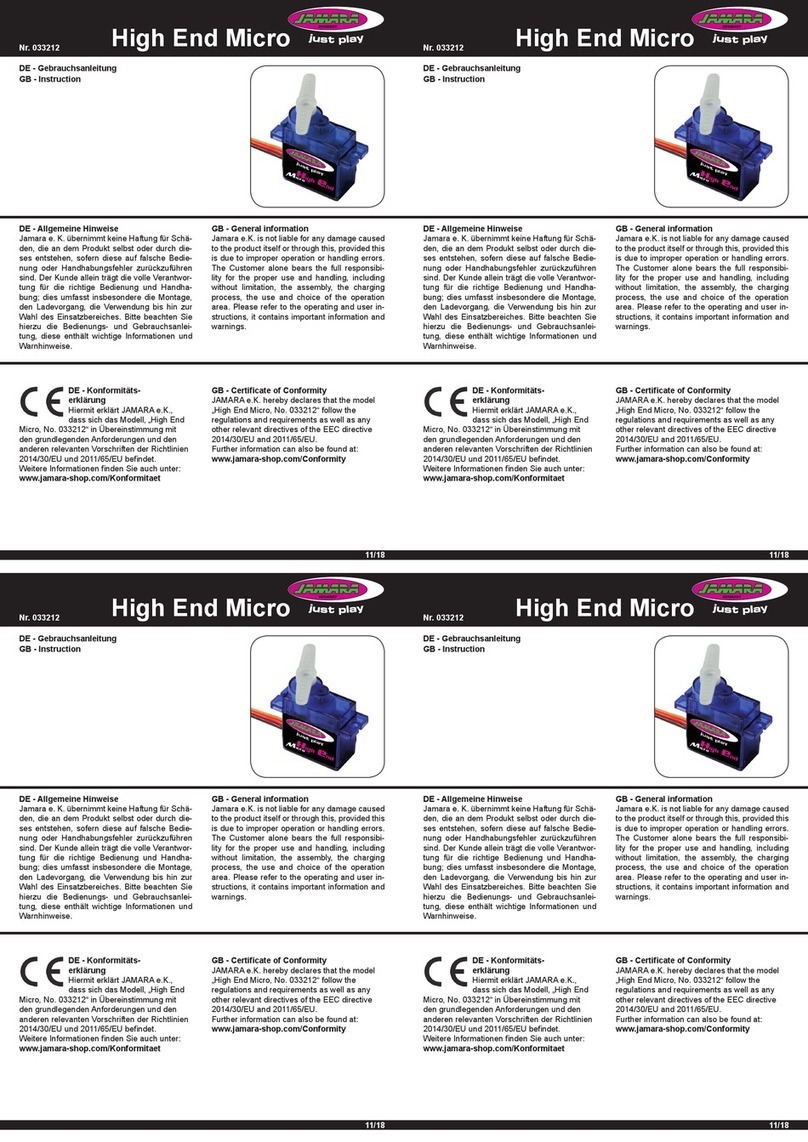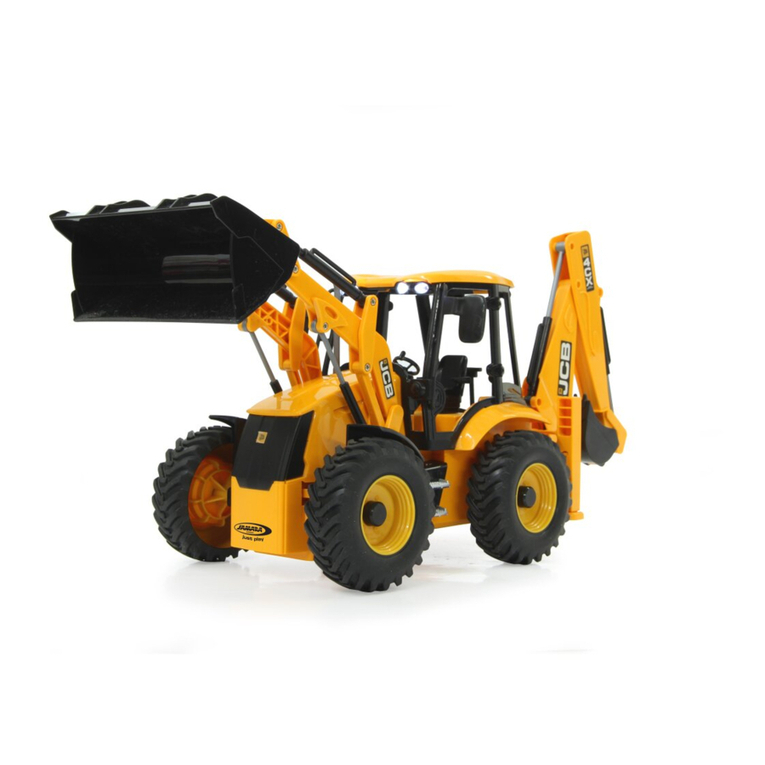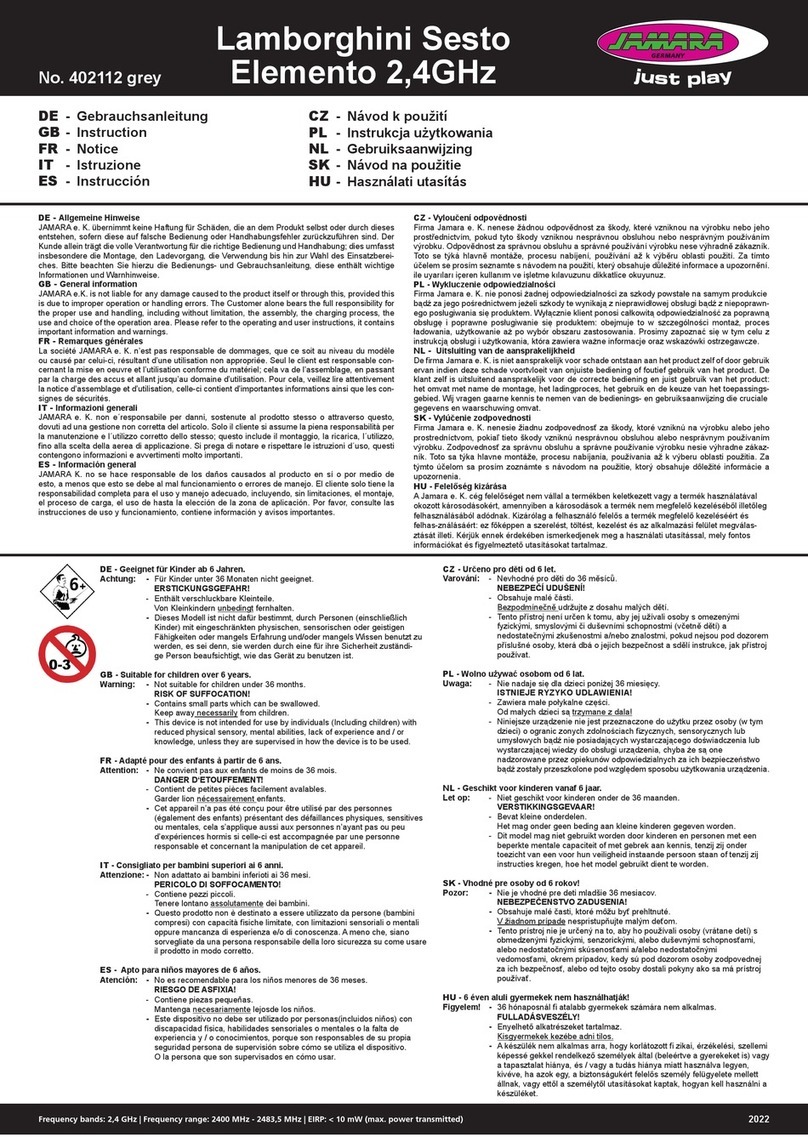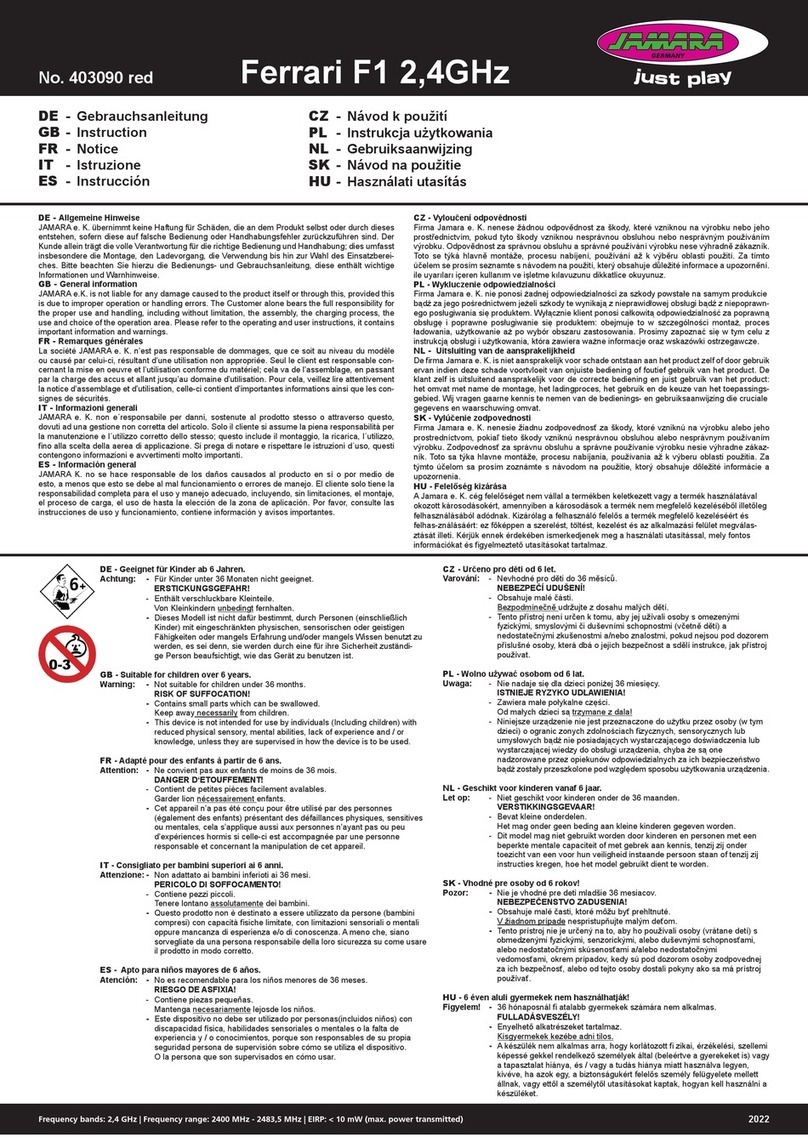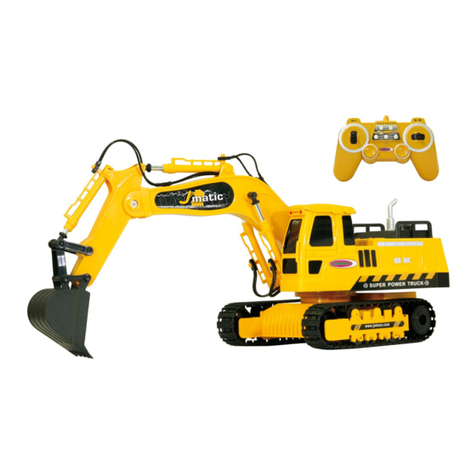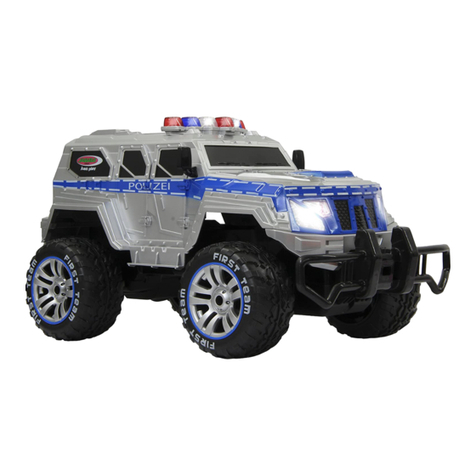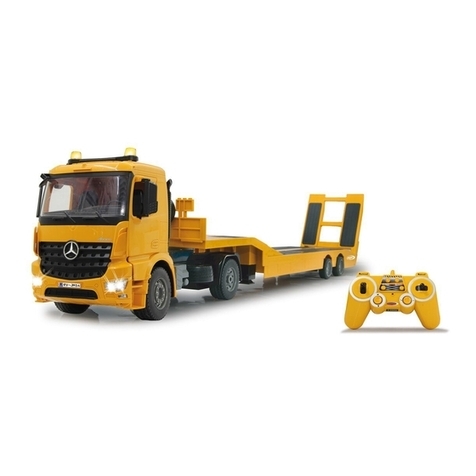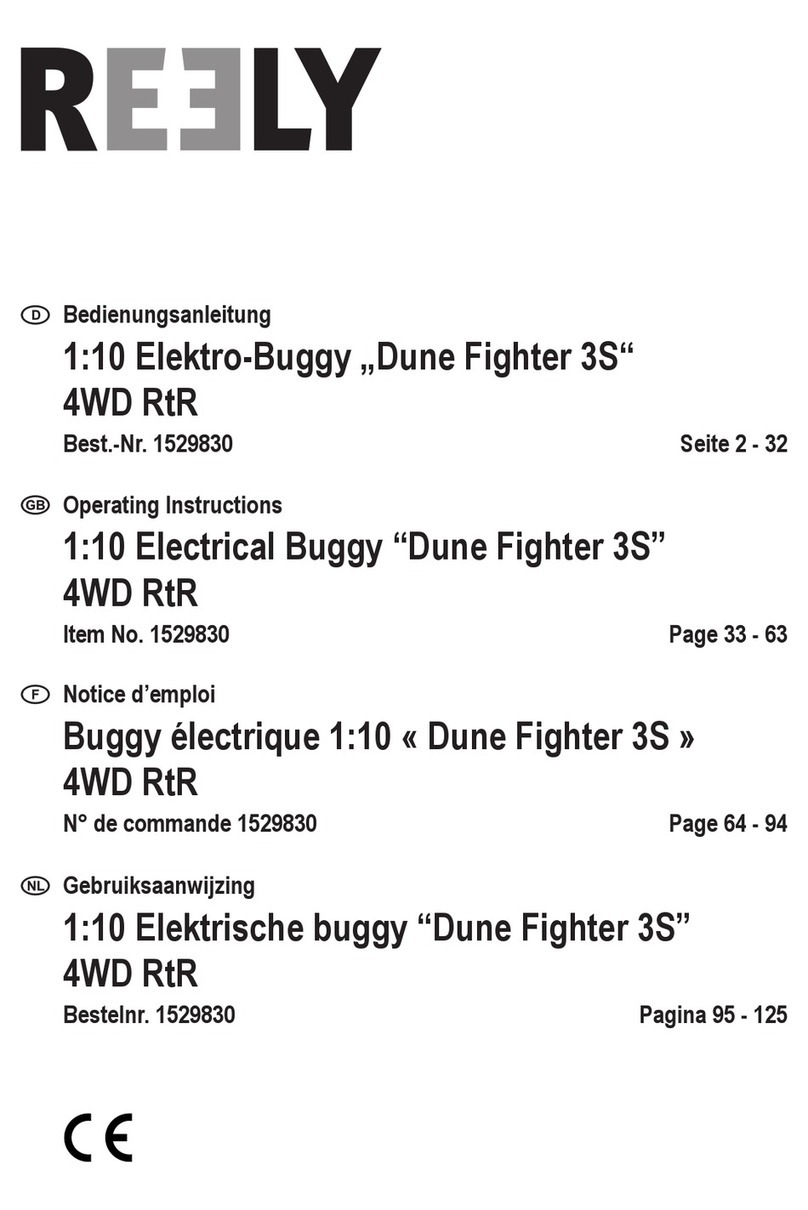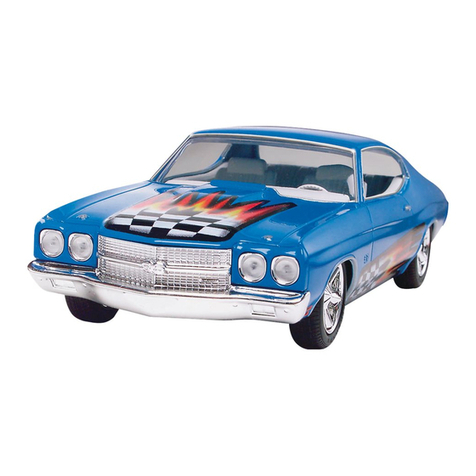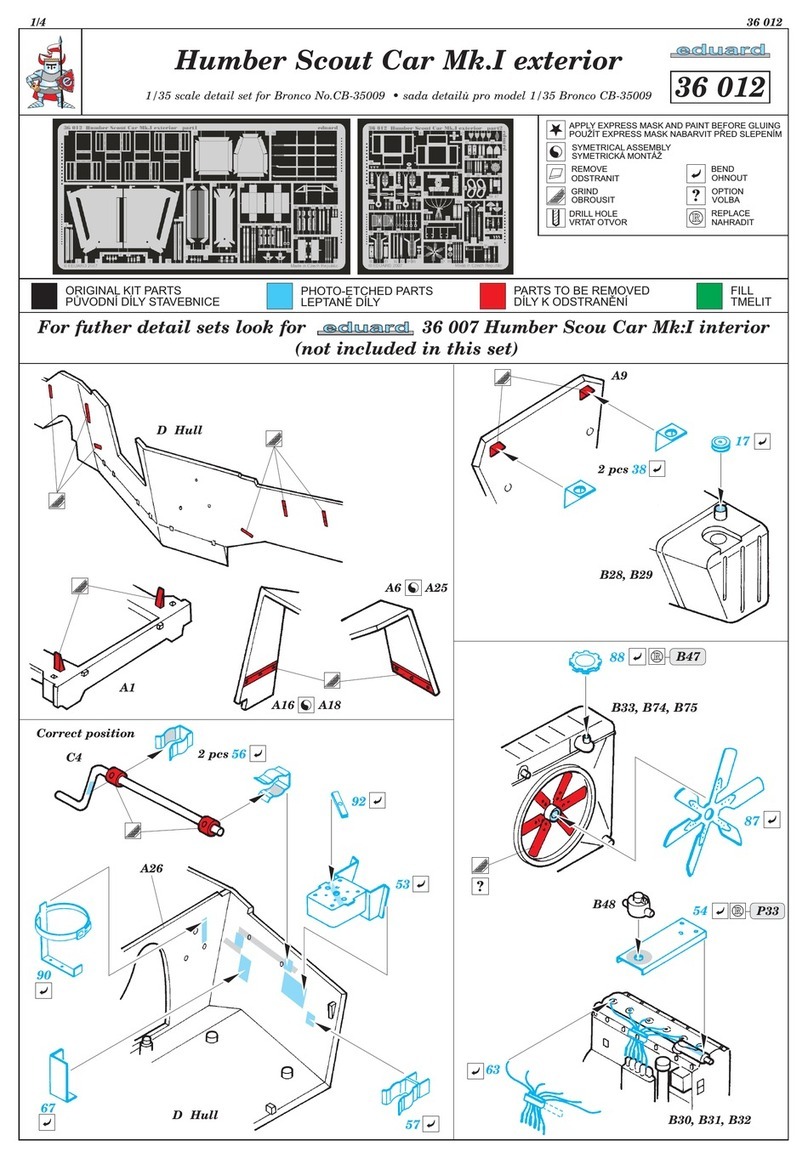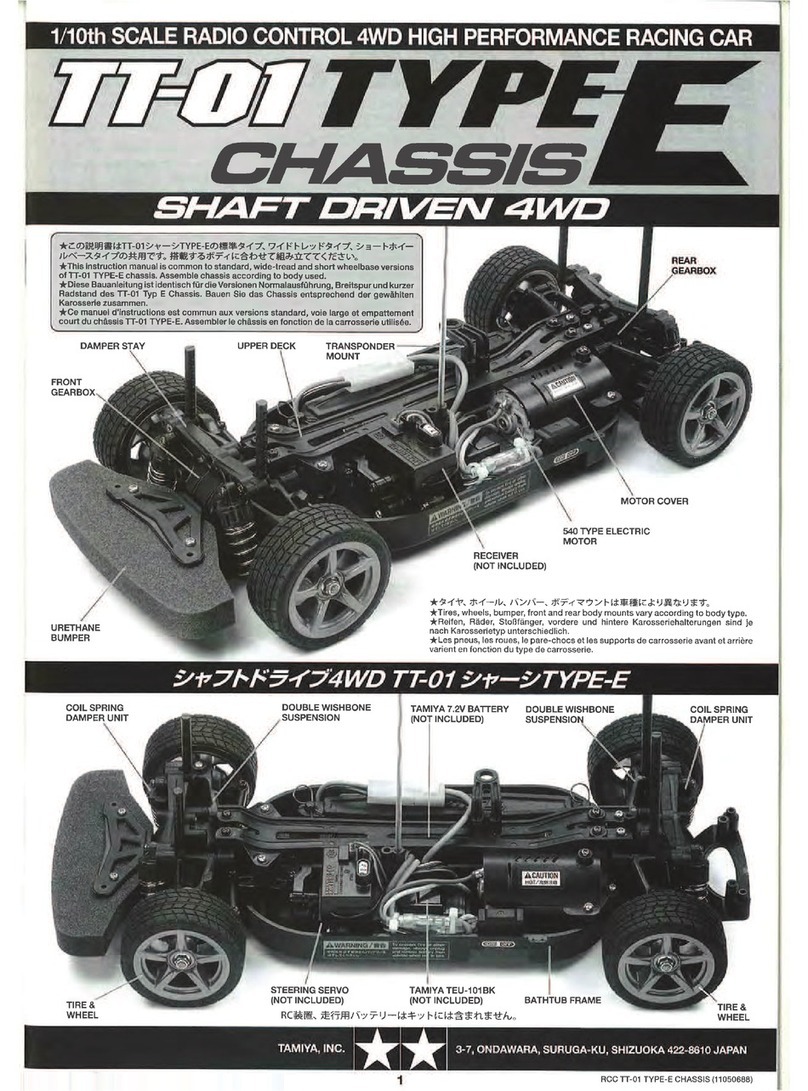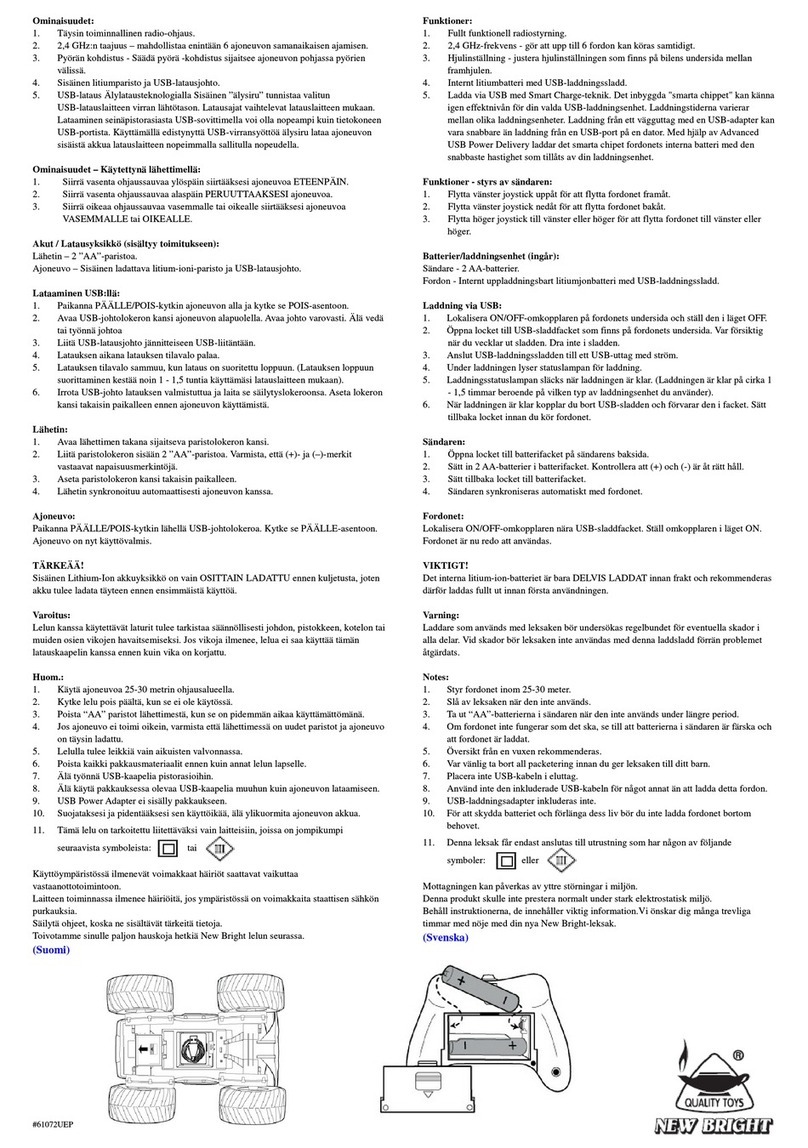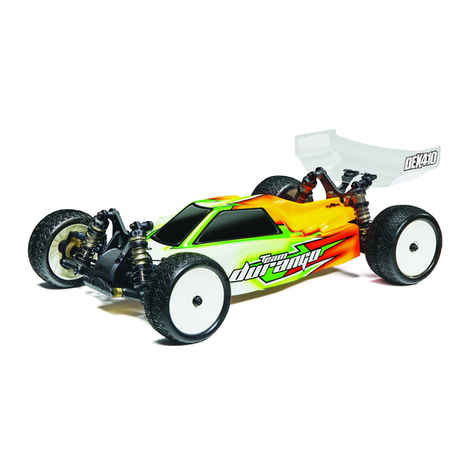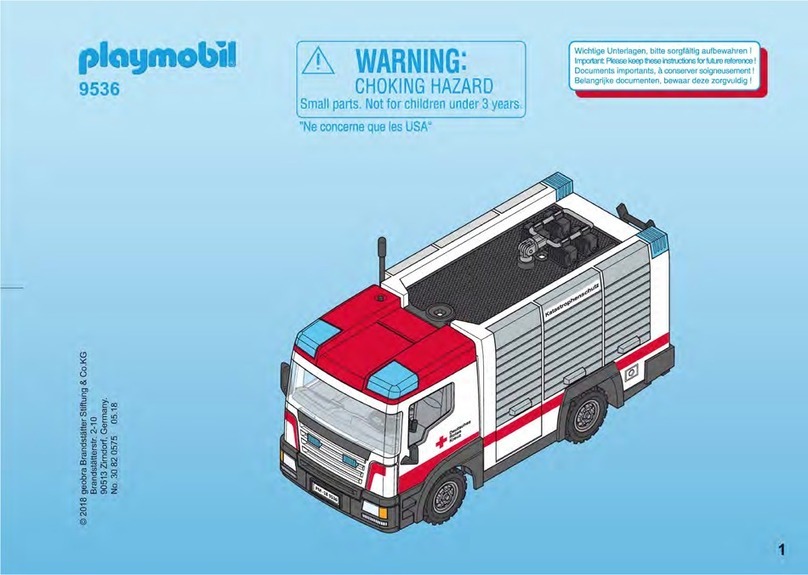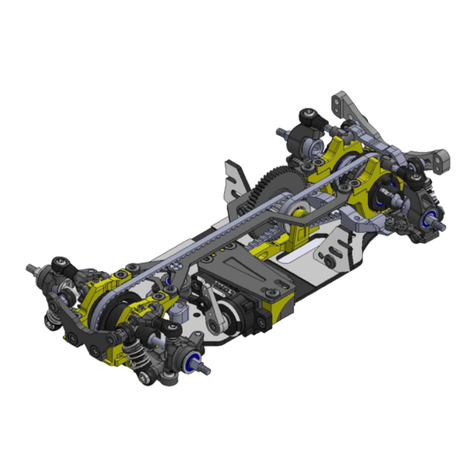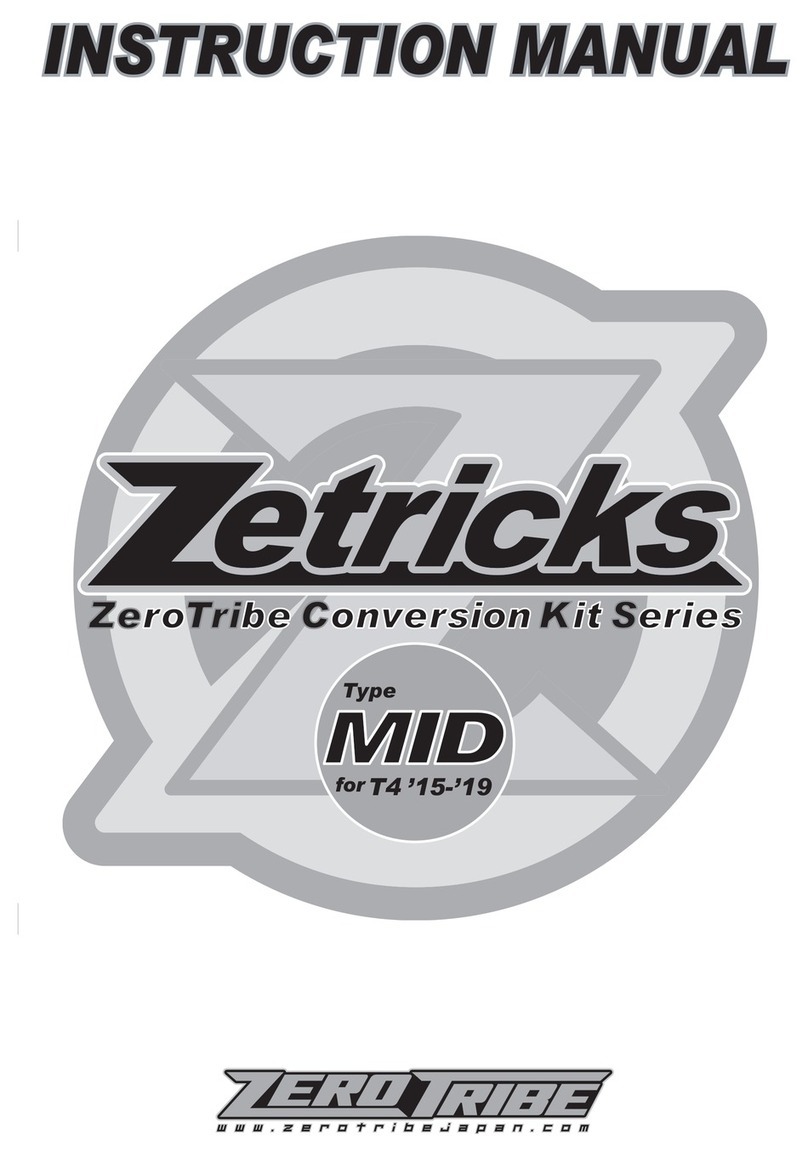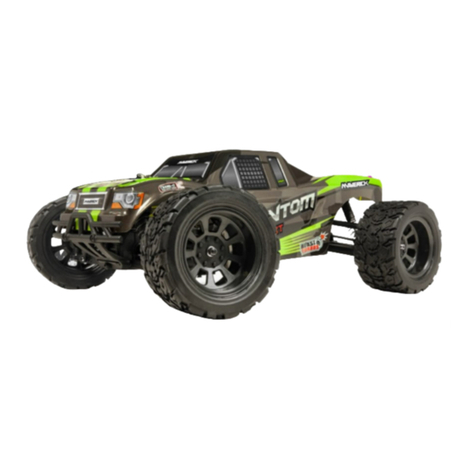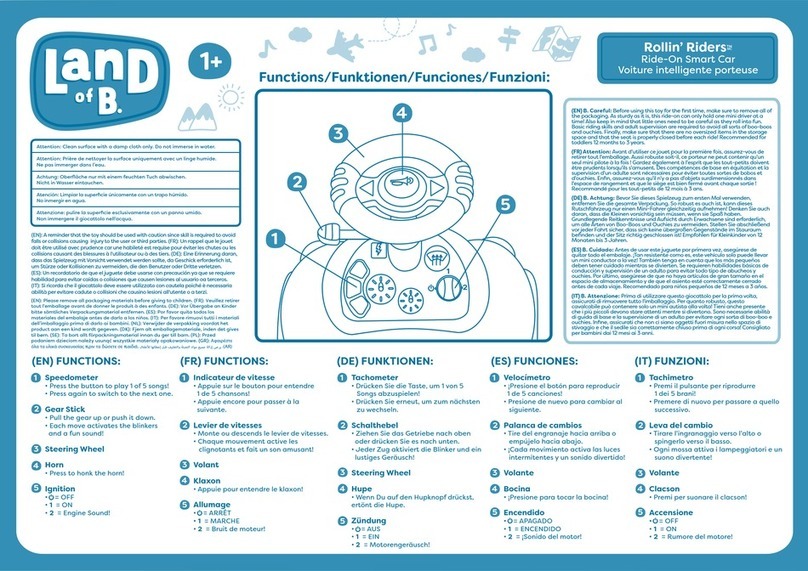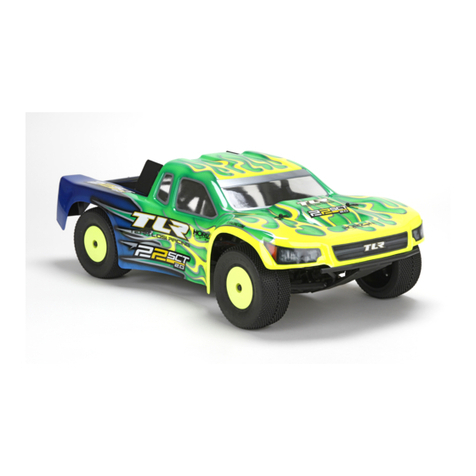
3
50 5080
50 5081
07 9996
50 5079
50 5080
50 5081
07 9996
50 5079
ES -
¡Atencion!
Su vehículo tiene un pivote de suspensión delantera. Esto tiene
numerosas ventajas. Es muy resistente y es de fácil mante-
nimiento. La conguración (setup) del carro ha sido diseñada
para que el eje motriz no se proyecte hacia afuera. Como con
cualquier modelo, los tornillos y los pernos se pueden perder
durante una interrupción del carro. Esto puede resultar en una
tolerancia del eje motriz. El eje motriz puede entonces proyec-
tarse hacia afuera si se ejerciera presión alta. El tornillo interno
de la bola (No. del artículo.: 505081)
le permitirá ajustar la tolerancia dando por resultado los ajustes
nos del ancho de la rodada. Para mejores resultados al colocar
la bola del pivote por primera vez, por favor ajuste siempre el
pivote superior y más bajo de la misma forma. Apriete tanto
como el pivote lo permita y que se pueda levantar
y bajar fácilmente pero no tanto que lo proyecte fuera si usted
le da un ángulo completo a la dirección. El tornillo del enchufe
de plástico (No. del artículo.: 505080) se utiliza solamente para
asegurar el nudillo de la dirección. Éste no
debe ser demasiado apretado, de lo contario la dirección no
queda suave y su manejo puede ser afectado negativamente.
GB
Attention!
Your vehicle has a pivot front suspension. This has a number of
advantages. It is very robust and easy to maintain. The set-up of
the car has been done so the drive shaft will not pop out. As with
any model, screws and bolts can losen during break-in of the
car. This can result in tolerance of the drive shaft. The drive shaft
can then pop out if high pressure is applied. The inner ball screw
(item No.: 505081) will enable you to adjust the tolerance resul-
ting in ne adjustments of the track width. For best results when
setting up the pivot ball for the rst time, please always adjust
the upper and lower pivot in the same way. Fasten as far as the
pivot can still be pulled up and down easyly but not as far that it
will pop out if you give full steering angle. The outer plastic socket
screw (item No.: 505080) is only used for securing of the steering
knuckle. This should not be too tight, otherwise the steering is
not smooth and the handling can be adversely aected.
ES
Atención!
La junta homocinética delantero y trasero absorbe la mayor
parte de la energía del motor y lo pasa al eje delantero
y trasero. Por lo tanto, los tornillos de cabeza hexagonal que
mantienen la junta homociética en el eje de salida de
transmisión antes del primero uso y en intervalos regulares (5-7
insertos) se debe controlar y se es necesarios apretar. En la
junta homocinética delantera y trasera se debe insertar un
anillo de goma. Controlar el juego del árbol motor. El margen
de juego debe ser aprox. 1-2 mm. Es necesario mover la junta
homocinética para adaptar el juego. Aquí tienen que aojar
los tornillos sin cabeza con un destornillador y ajustar la junta
homocinética. A continuación, atornillar los tornillos sin cabeza.
De lo contrario la junta homocinética se mueve en el eje de
salida de transmisión y la homocinética y el eje central se
pueden dañar.
GB
Attention!
The front and rear bone pan absorbs most of the motor‘s
energy and directs it to the front and rear axles. Therefore,
the hexagon socket screws which hold the bone pans on the
transmission output shafts must be checked and, if necessary,
tightened before the rst use and in regular intervals e.g 5-7
uses. Insert a rubber ring to the front and the back connection
cup. Please check the tolerance of the drive shaft. The tole-
rance should be approx. 1 – 2mm. You may have to move the
connection cups to adapt the tolerance. Therefore you need to
loosen the grub screws to adapt the connection cup.
Afterwards tighten the grub screws. If not, the connection cups
will move on the gear output shaft. That might cause the con-
nection cup and the middle drive shaft to get damaged.
ES - ¡Atención!
Si su modelo tiene un interruptor On/O es importante apagar
el modelo directamente después de cada uso. Si el modelo
tiene una batería extraible o un conector en la batería,
se debe desconectar inmediatamente después de cada uso
del modelo. Si se deja encendida la batería o conectada, la
batería se puede descargar. Una vez que está descargada
la batería pierde la potencía o se puede dañar grave. En
este caso la batería ya no puede ser cargada o descargada
y hay un peligro de in amación (peligro de incendio).
Nunca intentar de cargar o descargar baterías descargadas profundamente.
El voltaje de la batería nunca debe estar bajo 6 Voltios y la batería de NiMh nunca bajo
4 voltios para evitar descargas profundas. La batería completamente cargada tiene una
tensión de aproximadamente 8,4 Voltios y la batería NiMH de 8,5 voltios. Después de su
uso, la batería intacta se debe cargar inmediatamente completamente, después de una
fase de enfriamiento de al menos 10 minutos pero a más tardar después de 12 horas,
para evitar una descarga profunda a través del auto-descarga. Si la batería no se utiliza
o se pone en el almacenamiento es necesario comprobar o recargar la batería cada 3
meses, tensión (Para LiPo min. 8 voltios, para NiMh min. 7,4 voltios). En caso de daños
a la batería de disponer correctamente
GB - Danger.
Always switch o the model immediately after each use. Immediately after each use the
battery should be disconnected from the model. The battery can be deeply discharged
by leaving it switched on accidentally or leaving it plugged in. Deep discharge causes
the battery to lose power or can be damaged to such an extent that charging or dischar-
ging is no longer possible or the battery can self-ignite during charging or discharging
(re hazard). Never attempt to charge or discharge deep-discharge batteries.
The voltage of the LiPo batteries should never be under 6 volt and the NiMh battery
never under 4 Volt to avoid a depth discharge. The fully charged LiPo battery has a
voltage of approx. 8,4 Volt and the NiMH battery 8,5 Volt.
After usage, the intact battery has to be fully charged after a cooling phase of at least
10 min but not longer than 12 hrs. This is to avoid a deep discharge caused by a self-
discharge. When not using or storing the battery´s it has to be checked at least every
three months for voltage (For LiPo min. 8 Volt, for NiMh min. 7,4 Volt.) or damage and if
necessary charged or disposed.
ES
● Ahora ponga la batería en la porta baterías en el vehículo. Asegúrese de que el porta
baterías está asegurado correctamente con los 2 seguros para el porta baterías ncluidos.
● Conecte ahora la batería con el regulador del modelo. Si el enchufe del regulador y el echufe
de la batería no coinciden, se incluye un cable adaptador con su modelo.
● Encender la emisora y cerciórese de todos los botones del transmisor están en posición
neutral. Lea el capítulo para el uso del transmisor y sus controles cuidadosamente.
● Mantenga el carro en el aire en caso de que el controlador (ESC) del motor se encienda a su
máxima potencia.
● Encienda el control de la velocidad en el interruptor Encendido / Apagado (On / OFF).
● Le sugerimos que active ahora la unidad receptora a Prueba de Fallas en el armado.
Cuando se suministra, está desactivado.
● Si éste es su primer carro rc, le recomendamos conducirlo en una pequeña pista de prueba
para familiarizarse con el control del vehículo y los controles del transmisor.
GB
● Put the battery into the battery holder in the vehicle. Make sure that the battery holder is scured
properly with the 2 included clips for the battery holder.
● Now connect the battery to the speed control in the model. If the plug of the speed control and
battery do not match, then you will nd a connection lead in your box
● Turn the radio on and make sure all the trim buttons on the transmitter are in neutral position.
Read the chapter for usage of the transmitter.
● Keep the car in the air in case that the motor turns at full power.
● Switch the speed control on the On / O switch.
● We encourage you now to activate your receiver‘s built-in Failsafe unit.
On delivery it is turned o. (see chapter Fail Safe).
● If this is your rst rc car, we recommend to drive it on a small test track to familiarise yourself
with the control of the vehicle and the controls of the transmitter.
1
Regulador
ESC
ON/OFF
Batería
Battery
